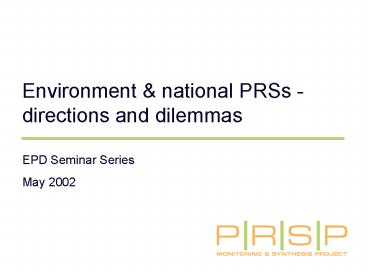Environment - PowerPoint PPT Presentation
1 / 17
Title:
Environment
Description:
Mixed record on poverty reduction in 1990s (Africa, Transition economies, post-1997 Asia) ... Coordination, reducing TCs, harmonisation. 15. Identifying entry points' ... – PowerPoint PPT presentation
Number of Views:12
Avg rating:3.0/5.0
Title: Environment
1
Environment national PRSs -directions and
dilemmas
- EPD Seminar Series
- May 2002
2
Organisation
- Overview of the PRS process
- Mainstreaming in a PRS context
- Objectives of DFID support
- Options for engaging on environmental issues
- Group work
3
Origins of the PRSP Idea
- Mixed record on poverty reduction in 1990s
- (Africa, Transition economies, post-1997 Asia)
- Findings on aid effectiveness projects,
- policy conditionality, ownership
- International Development Targets/MDGs
- Multilateral funding for debt relief (HIPC II)
4
Core PRSP Principles
- Country-led/owned based on broad-based
participation - Comprehensive macro, structural, social,
environmental - Long term perspective
- Results-oriented
- Costed prioritised
- Partnership-oriented
5
PRS Schedule Key Elements
Preparation Status Report
1st Annual Progress Report
2nd Annual Progress Report etc..
IMPLEMENTATION
PREPARATION
I-PRSP
PRSP (I)
PRSP (II)
9-24 months
2-5 years
HIPC(II) Completion Point
HIPC(II) Decision Point
6
PRS Schedule Key Elements
1st Annual Progress Report
Preparation Status Report
2nd Annual Progress Report etc.
I-PRSP
PRSP (II)
PRSP (I)
- PRSP elements
- Poverty analysis
- Goals/targets
- Prioritised policy actions
- Med-term budget fw
- Financing plan
- External assistance
- Participatory process
- Monitoring and evaluation
3 years
9-24 months
Comprehensive diagnosis
Selective actions
7
Links with other instruments
PRGF performance criteria/benchmarks (3 years)
IMF PRGF (replaces ESAF)
World Bank PRSC/other donor DBS
Performance indicators/PAFs
Goals targets (5-10 years)
I-PRSP
PRSP (I)
PRSP (II)
HIPC(II) Completion Point
HIPC(II) Decision Point
HIPC Triggers
8
Links with other national processes
Sector/cross-cutting strategies priorities
- PRSP elements
- Prioritised policy actions
- Med-term budget fw
I-PRSP
PRSP (I)
PRSP (II)
MTEF
Resource constraints Inter/intra-sectoral
priorities Service delivery Monitoring
Evaluation
9
Whats new?
- Costed poverty reduction strategy linked to
macro fiscal framework - Outcome focused making the links between policy
results - Opening-up the policy process to participation
- New incentives, new partnership possibilities
new forms of aid delivery
10
Emerging Experience
- Upgrading of poverty policy MoFs engaged
(Malawi) - Achieved at some cost to sentiments of national
- ownership but IFIs getting better at stepping
back (Mali) - Quality of PRS process document heavily
influenced - by density of previous strategy reform
effort(s) - Synergy with MTEFs especially important but there
is value-added in having PRSP as well (Rwanda,
Benin) - Sometimes catalyst for changing donor behaviour
(Bolivia), sometimes not
11
Emerging Experience
- Participatory processes generally limited to
consultation, - depth of understanding limited outside core
PRSP group - Ambitious targets, weak prioritisation
costing of policy - actions
- Anti-poverty content variable, sectoral focus,
weak - integration of cross-cutting themes/priorities
- Monitoring evaluation still the poor
relative, although this - is changing (Uganda, Rwanda, Tanzania,
Ethiopia, - Bolivia)
12
Mainstreaming in a PRS context
- Working through national systems and processes
- Poverty analysis (Nigeria workshop)
- Engaging civil society (Kenya)
- Influencing PRSP and other policy (Uganda NEMA)
- Monitoring and evaluation (Vietnam VDTs)
- Building on existing reform processes/efforts
- Uganda - Plan for Modernisation of Agriculture
- Rwanda MTEF and ubudehe
- Bolivia - decentralisation
13
Mainstreaming in a PRS context
- Working with through other donors
- Joint donor financing mechanisms in much of
Africa - Bolivia - bilateral JSA
- Poverty Task Force in Vietnam
- Engaging with a broad range of stakeholders
- Importance of PPAs (Rwanda, Uganda)
- Capacity building of organised civil society
(Kenya) - Working with the private sector (esp in
transition economies) - Sectoral and local government (Bolivia)
14
Objectives of DFID support
- Support for strong PRSs
- Poverty diagnosis, prioritisationlinks with
other reform processes - Coordination, reducing TCs, harmonisation
15
Identifying entry points
- Poverty analysis - input to the analysis to
ensure comprehensive? - PSIA - feed into ex ante analysis of impacts of
policies? - Priority areas - help with analysis of
sustainability of the selected priority actions?
- Organised civil society - support those working
in areas related to broad environment agenda? - Engaging with line ministries - when key
ministries are drafting their sectoral
strategies, can begin dialogue over
sustainability of key policy areas? - Working with other donors - look to fund
interventions jointly?
16
(No Transcript)
17
(No Transcript)































